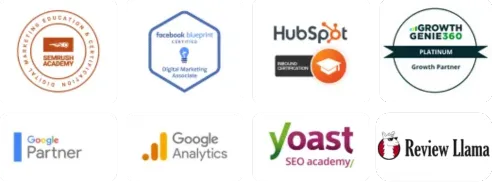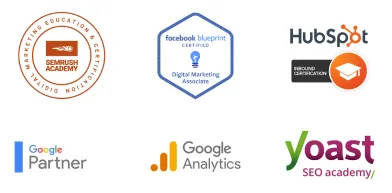TO LEARN IS TO GROW
Learning Center
We do our research and publish our results. Should probably call this the Growing Center.


What’s The Big Deal With Web Accessibility (And Why You Should Make Your Site Compliant Today)?
There has been a spike in compliance lawsuits regarding web accessibility in recent years, proving that businesses can no longer ignore this concern.
As it turns out, web accessibility is a significant challenge for U. S. businesses. Without proper web accessibility protocols in place, differently-abled folks would be unable to make use of the information on your site or do business with you.
So if you own or manage a business in the U.S., it is crucial that you understand what web accessibility is and the legal landscape it comes with.

What Exactly is Web Accessibility All About?
Web accessibility is a set of rules, behaviors, code standards, and design guidelines, that are meant to allow people with disabilities, which comprise 20% of the world’s population, to effectively use websites.
To achieve this, the W3C (The World Wide Web Consortium) has created the “Web Content Accessibility Guidelines” 2.1 (WCAG 2.1), which are meant to explain and guide developers on how to make websites accessible.
These guidelines have been adopted by governments around the world and are now a part of various legislations, such as the ADA, Section 508, EN 301549, and others.
The WCAG focuses mainly on three areas of accessibility: blind people using screen-readers (JAWS, NVDA), people with motor impairments that are using the keyboard, and a variety of other disabilities such as color blindness, epilepsy, and minor visual impairments that are mainly focused on the UI and design of the website (color contrasts, animations, fonts, etc.)

Which Web Accessibility Laws Do I Need To Know About?
Two primary laws strengthen the importance of web accessibility. First, there’s the Rehabilitation Act of 1973, America’s oldest accessibility-related legislation. Section 508 of this law requires any federal agency or department’s technologies to be accessible to those with disabilities.
Section 508 applies to all technologies that:
(1) will be used by federal employees and
(2) that will be utilized by the public to access a government agency’s services.
An expansion was later added to the provision to also include private organizations receiving federal funding, like educational institutions.
The second and more extensive U.S. law supporting web accessibility is the Americans with Disabilities Act (ADA). The ADA prohibits discrimination against individuals with disabilities in several industries, including public accommodations and businesses such as restaurants, hotels, doctors’ offices, libraries, parks, pharmacies, gyms and fitness centers, retail stores, museums, theaters, daycare centers, and public transportation.
While the ADA was enacted primarily to focus on physical accessibility, it’s now being applied to online websites, too. If a website proves to be inaccessible to people with disabilities, the business could be required to overhaul the website’s design until it demonstrates otherwise.
While this might sound simple, it can cost the company a significant amount in monetary damages, not including potential effects on its reputation and branding.

What Are The Differences Between These Laws?
It’s vital for a business to understand the differences between these two laws, especially since they apply to different entities. As such, each law will hold its own standards for compliance.
RA 1973’s Section 508 sets up rules primarily for government entities, but it doesn’t mean private companies are out of the woods. For private businesses, the notable portion of this law is that it also applies to organizations that receive federal funding. That means that once an organization takes any amount of money from the federal government, they automatically agree to follow the standards of Section 508. This statute of the law was highlighted a few years ago when a lawsuit was filed against government-supported Harvard University and MIT when the academic institutions failed to provide proper captioning to their online educational content.
The law also applies to contractors and third party businesses that federal organizations work with. Since they share the same network, any digital platform that their own employees interact with should also be readily accessible to the general public.
The ADA, on the other hand, is only concerned with the private sector. All employers are required by the ADA to provide reasonable accommodations to qualified applicants or employees, with no exceptions for people with disabilities.
The increase of digital businesses led the ADA to adjust their scope. Although the ADA was initially meant to curb physical challenges for disabled people, several consistent legal rulings requiring website compliance through the years have proven that the law also extends to online venues. In 2018 alone, over 2,000 ADA lawsuits were filed for web accessibility cases, showing clear evidence that plaintiffs are serious about the law and its online jurisdiction.
What Should I Do To Be Compliant With U.S. Web Accessibility Guidelines?
Despite being strict on web accessibility, neither the ADA nor Section 508 actually contains specific rules for achieving web compliance. In fact, the ADA does not address websites at all in its clauses.
For Section 508, according to a ruling in early 2018, the Web Content Accessibility Guidelines (WCAG) 2.0 of the World Wide Web Consortium (W3C) would be the standard by which organizations should abide by the law. The same applies to government-funded institutions and all businesses looking to work with a government agency in any capacity.
The WCAG uses four main requirements to make a list of recommendations for creating online content accessible to people with disabilities. According to the WCAG, the website should be:
(1) perceivable, meaning all users can see and read the site content, including the visually-impaired,
(2) operable, which pertains to the website’s overall navigation difficulties across multiple platforms and devices,
(3) understandable, meaning the website is properly organized and set in a language that most users can understand,
and finally, (4) robust, which means it should integrate digital tools (Assistive Technology or AT) that are commonly used by people with disabilities.

How Do I Make My Business Website More Accessible?
As more business owners are recognizing the importance of web accessibility, there are now services that help websites become more compliant, allowing people with disabilities to finally use them.
One such service is AccessAPal. AccessAPal is the first and only AI-powered solution that is revolutionizing the industry by making web accessibility simple, automatic, immediate, and affordable, in compliance with the WCAG 2.1, ADA, Section 508, and other worldwide legislation.
AccessAPal utilizes two components that, together, achieve compliance.
The first is its foreground application, the accessibility interface, which is responsible for 30% of the requirements, mostly UI and design-related.
The second is its background application (AI, Machine Learning powered), which is responsible for the remaining 70% of requirements, mostly related to blind people’s screen-reader adjustments, and keyboard navigation optimizations for people with motor impairments.
AccessAPal will start processing your website right after the initial installation and the process takes up to 48 hours. Upon completion, you’ll receive an Accessibility Statement and certification of performance directly to your email.

A Final Word on Web Accessibility
To avoid having any issues, you should learn to evaluate web accessibility early in your website’s development process. The sooner you can identify any opportunities for improvement, the easier it will be to address them, especially if you’re still in the process of designing the initial webpage.
It is most efficient and effective to incorporate accessibility right from the beginning to not need to go back and re-do anything.
While some accessibility aspects are quite complex and need a comprehensive evaluation to address, there are also simple solutions for other accessibility concerns.
AccessAPal’s AI-powered web accessibility solution easily and effortlessly checks your business website for accessibility problems and makes adjustments to your site automatically, thereby eliminating many potential issues in the future.
All businesses, big and small, should always consider web accessibility for all online technologies. Any perceived lack of compliance can result in financial losses, a negative public image, or difficulties securing federal grants and government contracts.
For more details on how AccessAPal can work for you and your business, visit the official website today and ask for an online appointment with the AccessAPal team to know more.
Built for Growth. Backed by 25 Years of Trust.
For over two decades, LOJO has been a trusted partner to hundreds of businesses just like yours. Whether working directly with owners, managers, teams, or boards of directors, our goal remains the same: to be a reliable and results-driven asset to your business.
Over the years, we’ve carefully built a team of experts—each selected for their unique skills, strengths, and personalities. Our clients choose LOJO because they know we genuinely care about their success.
And after 25 years of helping businesses grow, we’re more committed than ever.


Built for Growth. Backed by 25 Years of Trust.
For over two decades, LOJO has been a trusted partner to hundreds of businesses just like yours. Whether working directly with owners, managers, teams, or boards of directors, our goal remains the same: to be a reliable and results-driven asset to your business.
Over the years, we’ve carefully built a team of experts—each selected for their unique skills, strengths, and personalities. Our clients choose LOJO because they know we genuinely care about their success.
And after 25 years of helping businesses grow, we’re more committed than ever.




Matthew Rogers, President
iProspect Check
After spending several months reviewing multiple proposals from several different companies we engaged LOJO to develop a new website that represents our company effectively. We worked initially with Stephen Platte who helped create the scope of the project. Stephen was knowledgeable and always followed up with me on time and as promised.
He "closed the deal" for LOJO with his professionalism, service orientation and easy going approach. Once we signed the contract we were introduced to Jay Kelly who would be the creative lead for LOJO. This was the most challenging part of the project for my company, as there was no shortage of ideas from our side. Jay managed the project flawlessly, and once we had all agreed to the design, Jay introduced us to Eric.
Eric Lay is one of the founders of LOJO. Eric took the design we had developed and brought it to life. We delivered content as quickly as he requested it. Eric kept the project on task and we responded by exceeding every deadline for content. In turn, once provided, literally not a day went by that Eric didn't add the content and take the next step. In just a few weeks we launched our new website. Eric is a pleasure to work with.
His positive attitude and consultative approach really enhanced the experience and made a big difference for us in the outcome of our project. We would welcome you to visit our website to take a look at the quality work of LOJO. We are very pleased with LOJO and look forward to working with them in the future as we pursue an aggressive SEO strategy."
After spending several months reviewing multiple proposals from several different companies we engaged LOJO to develop a new website that represents our company effectively. We worked initially with Stephen Platte who helped create the scope of the project. Stephen was knowledgeable and always followed up with me on time and as promised.
He "closed the deal" for LOJO with his professionalism, service orientation and easy going approach. Once we signed the contract we were introduced to Jay Kelly who would be the creative lead for LOJO. This was the most challenging part of the project for my company, as there was no shortage of ideas from our side. Jay managed the project flawlessly, and once we had all agreed to the design, Jay introduced us to Eric.
Eric Lay is one of the founders of LOJO. Eric took the design we had developed and brought it to life. We delivered content as quickly as he requested it. Eric kept the project on task and we responded by exceeding every deadline for content. In turn, once provided, literally not a day went by that Eric didn't add the content and take the next step. In just a few weeks we launched our new website. Eric is a pleasure to work with.
His positive attitude and consultative approach really enhanced the experience and made a big difference for us in the outcome of our project. We would welcome you to visit our website to take a look at the quality work of LOJO. We are very pleased with LOJO and look forward to working with them in the future as we pursue an aggressive SEO strategy."

Matthew Rogers, President
iProspect Check
The team at LOJO were wonderful to work with. They are well organized and very patient as we worked through our marketing strategy and developed a well thought out and clear action plan at a reasonable price. We will definitely be back for our future campaign needs."

Jon Crosby, Founder
Dazil

